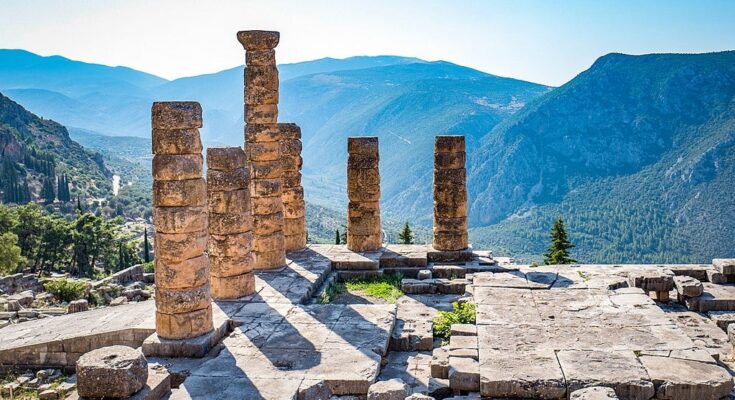The ancient Greek Oracle of Delphi, part of one of the most iconic ancient places in Greece, has become a byword for prophecy all around the globe; and many of the glories of Delphi’s architecture and art have survived to this day.
Amid a backdrop of staggeringly beautiful natural surroundings, the many monuments of Delphi speak to the ancient history of the place. Visitors may well understand when they are there why the ancient Greeks believed this was the very center of the entire world.
According to the Byzantine-era encyclopedia called the Suda, Delphi took its name from the Delphyne, the she-serpent (drakaina) who lived there which was killed by the god Apollo. However, in other accounts, the serpent was the male serpent (drakon) called Python.
On the north side of the valley junction a spur of Parnassus looming over the valley made narrower by it is the site of ancient Krisa, which once was the ruling power of the entire valley. Both Amphissa and Krisa are mentioned in the Iliad’s “Catalogue of Ships.” It was a Mycenaean stronghold. Krisa itself is Middle Helladic, from 1,900 to 1,550 BC.
According to the ancient Greek tragedian Aeschylus, in the prologue of the “Eumenides,” the oracle had its origins in prehistoric times and the worship of the earth goddess, Gaia.
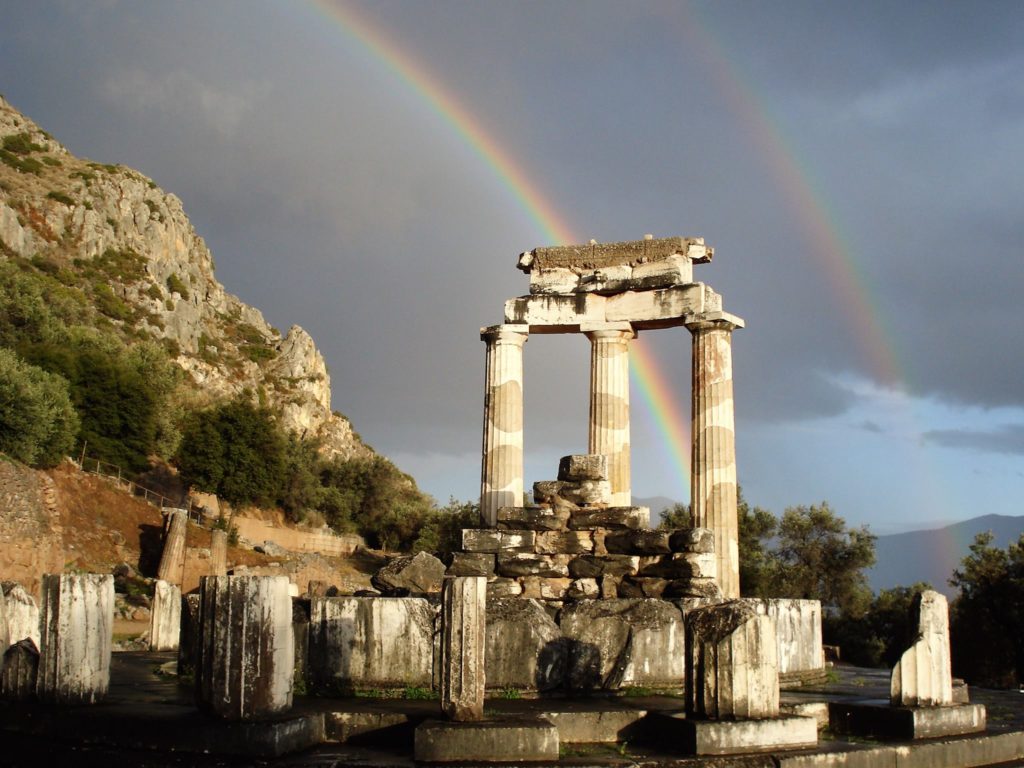
Zeus was said to have determined the site of Delphi after he sought to find the center of his “Grandmother Earth” (Gaia). He sent two eagles flying from the eastern and western extremities of the earth, and the path of the eagles crossed over Delphi, where the omphalos, or navel of Gaia, was found.
Human occupation of the site at Delphi can be traced back to the Neolithic period, from 6,800 to 3,200 BC, with extensive occupation and use beginning in the Mycenaean period, from 1,600–1,100 BC.
The town started to gain pan-Hellenic relevance as both a shrine and an oracle in the 7th century BC, however.
The name Delphi comes from the same root as δελφύς, or “womb,” and may indicate the veneration of Gaia since the enormous cliff with a huge cleft in it near the site was referred to as “the womb of the world.”
The staggeringly beautiful area is recognized by UNESCO as a World Heritage Site because of its great influence in the ancient world, as evidenced by the many monuments built there by most of the important ancient Greek city-states.
Indeed, it would be impossible to remove the influence of the Delphic oracle from the written history of the times — or from Western history itself, where the word oracle has been passed down in all languages as a byword for prophecy.
Located on the southwestern slopes of Mount Parnassus, Delphi is one of Greece’s most enormous and important archaeological sites. It has been part of Parnassos National Park since 1938.
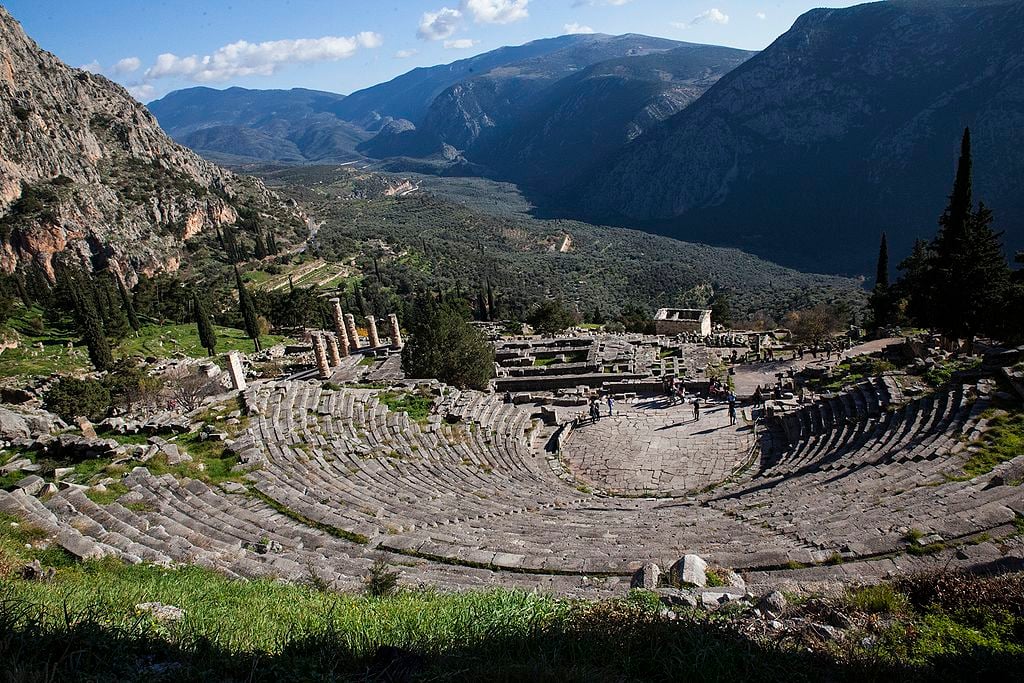
Greece’s ancient Oracle of Delphi
According to Greek legend, Delphi was previously called Pytho (Πυθώ), a sacred place which served as the seat of Pythia, the major oracle who was consulted about important decisions throughout the ancient classical world. A copy of the stone monument known as the omphalos (navel) of Mother Earth — still exists in there today.
The Oracle of Delphi, the Pythia, who was also referred to as the sibyl, was a priestess who would prophesy from the tripod in the sunken adyton of the Temple of Apollo. The god himself was believed to speak through this oracle.
When asked a question, the Oracle — perhaps quite cunningly — never gave a direct answer, but spoke in allegories with “hidden meanings” and “ambiguities,” according to Plutarch, who was himself a priest of Apollo and a great historian. It was then up to the inquiring party as to how to interpret them.
As the prophecy was regarded as the true word of divinity, the actual meaning, if it could be known, must be absolute truth. Believing this principle to be true, many of the best historians of the time spent a great deal of time trying to interpret oracular myths as actual realities.
She had to be an older woman of blameless life chosen from among the peasants of the area. Alone in an enclosed inner sanctum (Ancient Greek adyton – “do not enter”) the Oracle sat on a tripod seat over an opening in the earth (the “chasm”).
According to legend, when Greek god Apollo slew Python, its body fell into this fissure and fumes arose from its decomposing body. Intoxicated by the vapors, the sibyl would fall into a trance, allowing Apollo to possess her spirit. In this state she prophesied. The oracle could not be consulted during the winter months, for this was traditionally the time when Apollo would live among the Hyperboreans. Dionysus would inhabit the temple during his absence.
While in a trance, the Pythia “raved” – most likely a form of ecstatic speech – and her ravings were “translated” by the priests of the temple into elegant hexameters. It has been speculated that the ancient writers, including Plutarch — who had worked as a priest at Delphi — were correct in attributing the oracular effects to the sweet-smelling pneuma, or vapor, escaping from the chasm in the rock.
The Delphic oracle exerted considerable influence throughout the Greek world, and she was consulted before all major undertakings including wars and the founding of colonies. She also was respected by the Greek-influenced countries around the periphery of the Greek world, such as Lydia, Caria, and even Egypt.
Great Religious Significance of Delphi, Greece
Delphi became the site of a major temple to Phoebus Apollo, as well as the Pythian Games and the Oracle. Even in Roman times, hundreds of votive statues remained, described by Pliny the Younger and seen by Pausanias. Carved into the temple were three phrases: γνῶθι σεαυτόν (gnōthi seautón, or “Know thyself”); μηδὲν ἄγαν (mēdén ágan, or “Nothing in excess”), and Ἑγγύα πάρα δ’ἄτα (engýa pára d’ata, or “Make a pledge and mischief is nigh”).
The actual authorship of the three maxims set up on the Delphi temple may always be a point of conjecture. Most likely they were popular proverbs, which tended later to be attributed to certain Greek thinkers.
The Temple of Apollo appears regularly in Homeric literature. In the “Iliad,” Achilles would not accept Agamemnon’s peace offering even if it included all the wealth in the “stone floor” of “rocky Pytho”. In the “Odyssey,” Agamemnon crosses a “stone floor” to receive a prophecy from Apollo in Pytho.
The historian Hesiod also refers to Pytho “in the hollows of Parnassus” in his work “Theogony.” These references imply that the earliest known date of the oracle’s existence is the 8th century BC, the probable date of composition of the Homeric works. Earlier times of existence cannot be excluded, of course, if the written poems are adaptations of earlier oral ones.
The Homeric Hymn, “To Apollo,” is the oldest of the three loci, dating to the 7th century BC. Apollo is connected with the site by his epithet Δελφίνιος Delphinios, “the Delphinian.”
The story goes that Apollo travels about after his birth on Delos seeking a place for an oracle. He is advised by Telephus to choose Krisa,”below the glade of Parnassus,” which he does, and has a temple built, killing the serpent that guards the spring.
Subsequently, some Cretans from Knossos sailed up on a mission to reconnoiter Pylos. Changing into a dolphin, Apollo cast himself on their boat’s deck. The Cretans did not dare to remove him, but sailed on. Apollo then guided the ship around Greece, ending back at Krisa, where the ship ran aground. Apollo then entered his shrine with the Cretans as its priests, who worshipped him as Delphineus, “of the dolphin.”
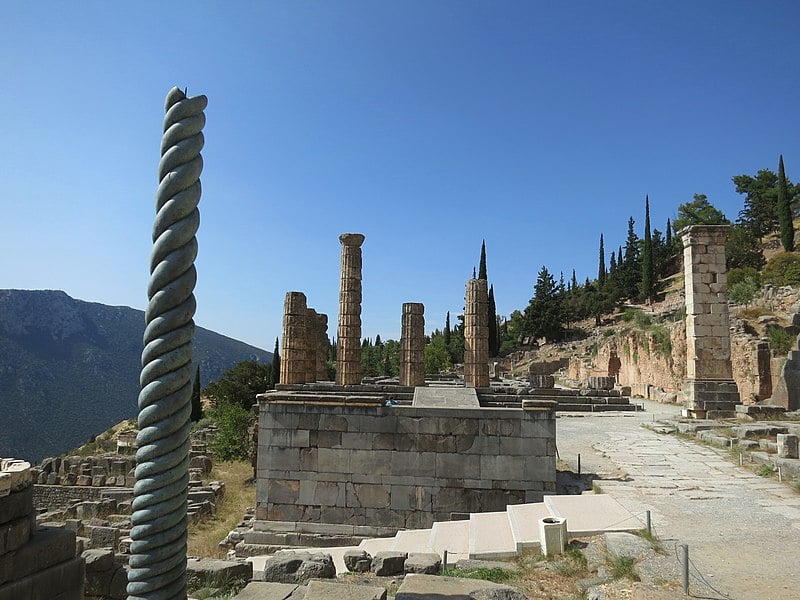
Pythian Games of Delphi and Theoxenia Festival
The athletic contests known as the Pythian Games took place in Delphi every four years to commemorate Apollo. Another regular Delphi festival was the “Theophania” (Θεοφάνεια), an annual festival in spring celebrating the return of Apollo from his winter quarters in Hyperborea, the frozen land at the top of the world.
The culmination of the festival was a display of an image of the gods, usually hidden in the sanctuary, to worshippers.
The Theoxenia was also held each summer, centered on a feast for “gods and ambassadors from other states.” Myths say that Apollo killed the chthonic serpent Python which guarded the Castalian Spring and named his priestess Pythia after her. Python, who had been sent by Hera, had attempted to prevent Leto, while she was pregnant with Apollo and Artemis, from giving birth.
This spring flowed toward the temple but disappeared beneath it, creating a cleft which emitted chemical vapors that purportedly caused the oracle at Delphi to reveal her prophecies. Apollo killed Python but had to be punished for it, since he was a child of Gaia. The shrine dedicated to Apollo was originally dedicated to Gaia and shared with Poseidon. The name Pythia remained as the title of the Delphic oracle.
Excavation at Delphi has uncovered great numbers of artifacts increasing steadily in volume, beginning with the last quarter of the 8th century BC. Pottery and bronze as well as tripod dedications continue in a steady stream — in contrast to Olympia, another sacred site in those times.
Most of the ruins that survive today date from the most intense period of activity at the site during the 6th century BC.
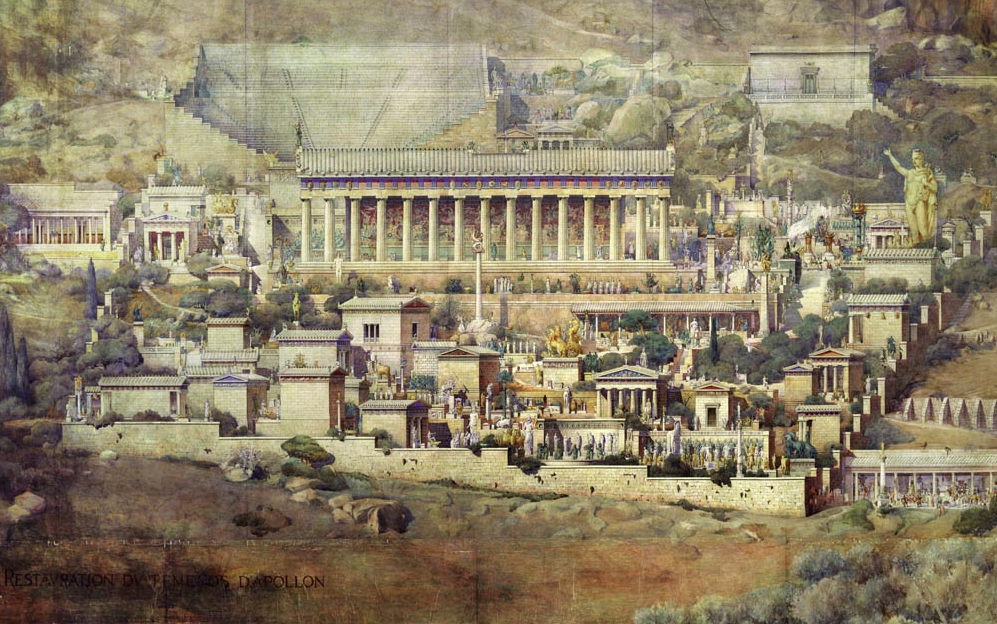
Archaeology Uncovers Splendor of Ancient Delphi under layers of settlements
The modern town of Delphi was created by moving the village off the hallowed ground, of which nearly every inch is a monument, so that the site could be excavated by the French School of Archaeology, working in conjunction with Greek authorities.
The spectacular ruins date from the ancient classical period, from the eighth century to the sixth century BC, with some in the late antique period. In order to find them, however, the first excavators, from the French School of Athens, had to clear away many tons of later buildings, as well as soil that had accumulated, atop the ancient site.
All this evidence of post-classical-era settlements built atop ancient Delphi were sacrificed in favor of the earlier ruins, which we see today.
The lack of any trace of intervening time gives the impression of a sudden ruination of the site, which is false. After Hellenic society transitioned from pagan to Christian, Delphi remained just as popular as it had been for some time, and it was never completely abandoned as a village. While still pagan, it often honored the emperors of Christian-era Rome. Both religions were practiced there side-by-side for a time.
Finally, however, consultation of the oracle declined to such a degree that Delphi could no longer be maintained as a site of ancient religious worship and ritual.
1893 Excavations Uncover Temples of Apollo, Athena Pronoia
In 1893, the French Archaeological School removed vast quantities of soil from numerous landslides that had taken place there to reveal both the major buildings and structures of the sanctuary of Apollo and Athena Pronoia, along with thousands of priceless objects, inscriptions and sculptures.
During that excavation, architectural members from a 5th-century Christian basilica were also uncovered, from the time when Delphi served as a bishopric. Other important Late Roman buildings are the Eastern Baths, the house with the peristyle, the Roman Agora, and the large cistern. At the outskirts of the city late Roman cemeteries are to be found.
To the southeast of the sanctuary of Apollo lay the so-called Southeastern Mansion, a building with a 65-meter (213 foot) long façade, spread over four levels, with four triclinia and private baths. Large storage jars stored provisions, and other pottery vessels and luxury items were discovered in the rooms.
Among the more spectacular finds was a tiny leopard made of mother of pearl, possibly of Sassanian origin, which is now on display in the Delphi Archaeological Museum, on the premises.
The mansion, which dates back to the beginning of the 5th century, functioned as a private house until 580; later, it was transformed into a potters’ workshop.
Main Street of Delphi was the Sacred Way
The ruins of the Temple of Apollo in Delphi visible today date from the 4th century BC, and are of a peripteral Doric building. It was erected by Spintharus, Xenodoros, and Agathon on the remains of an earlier temple, dated to the 6th century BC, which itself was erected on the site of a 7th-century BC construction attributed in legend to the architects Trophonios and Agamedes.
Ancient tradition accounted for four temples that successively occupied the site before the 548/7 BC fire, following which the Alcmaeonids built a fifth. The poet Pindar celebrated the Alcmaeonids’ temple and he also provided details of the third building. Other details are given by Pausanias and the Homeric Hymn to Apollo.
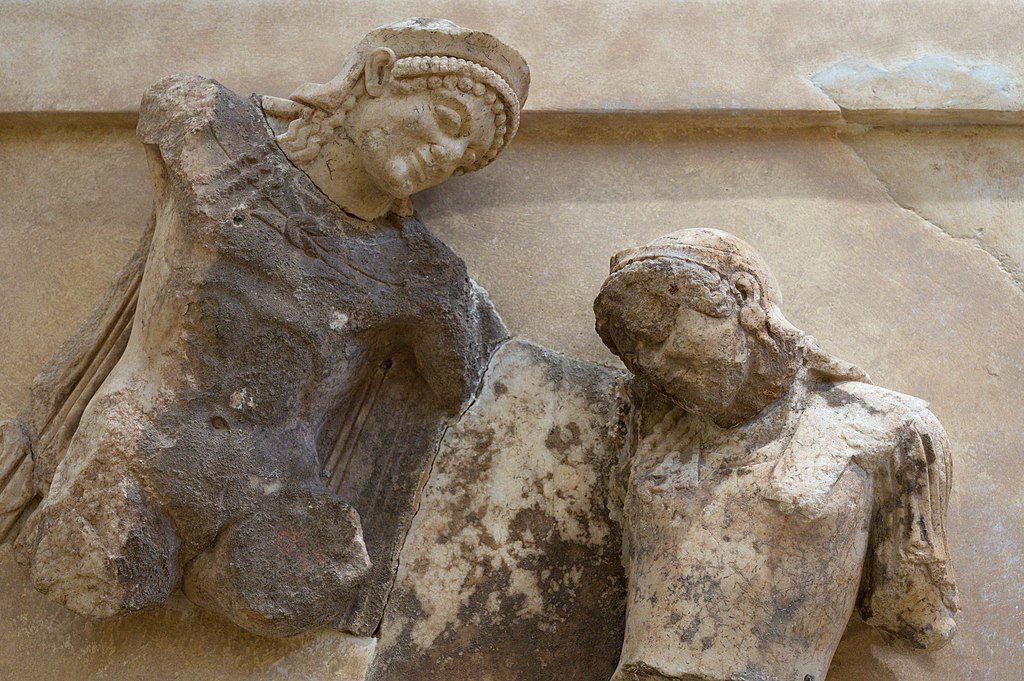
Treasury of the Athenians built to commemorate victory at Battle of Marathon
From the entrance of the upper site, continuing up the slope on the Sacred Way almost to the Temple of Apollo, are a large number of votive statues, and numerous so-called “treasuries.” These were built by many of the Greek city-states to commemorate victories and to thank the oracle for her advice which was thought to have contributed to those victories.
These buildings held the offerings made to Apollo; these were frequently a “tithe” or tenth of the spoils of a battle. The most impressive is the now-restored Athenian Treasury, built to commemorate their victory at the Battle of Marathon in 490 BC.
The Siphnian Treasury was dedicated by the city of Siphnos whose citizens gave a tithe of the yield from their silver mines until the mines came to an abrupt end when the sea flooded them.
One of the largest of the treasuries was that of Argos. Having built it in the late classical period, the Argives took great pride in establishing their place at Delphi amongst the other city-states. It was completed in 380 BC.
Located in front of the Temple of Apollo, the main altar of the sanctuary was paid for and built by the people of the Greek island of Chios. It dates back to the 5th century BC, as evidenced by the inscription on its cornice. Made entirely of black marble, except for the base and cornice, the altar would have made a striking impression. It was restored in 1920.

Stoa of the Athenians
The stoa, or open-sided, covered porch, is located along the base of the polygonal wall retaining the terrace on which the Temple of Apollo sits. The stoa opened to the Sacred Way. The nearby presence of the Treasury of the Athenians suggests that this quarter of Delphi was used for Athenian business or politics, as stoas are generally found in market-places.
Although the architecture at Delphi is generally Doric, a plain style, in keeping with the Phocian traditions, which were Doric, the Athenians did not prefer the Doric. The stoa was built in their own preferred style, the Ionic order, the capitals of the columns being a sure indicator.
In the Ionic order they are floral and ornate, although not as much as the Corinthian. The remaining porch structure contains seven fluted columns, unusually carved from single pieces of stone (most columns were constructed from a series of discs joined together). The inscription on the stylobate indicates that it was built by the Athenians after their naval victory over the Persians in 478 BC, to house their war trophies.
The Sibyl rock
The Sibyl rock is a pulpit-like outcrop of rock between the Athenian Treasury and the Stoa of the Athenians upon the sacred way which leads up to the temple of Apollo. It is claimed to be where an ancient Sibyl — pre-dating the Pythia of Apollo — sat to deliver her prophecies.The Pythia might have stood there, or an acolyte whose function was to deliver the final prophecy. The rock does seem to be ideal for public speaking.
The Theatre at Delphi
The ancient theatre at Delphi was built further up the hill from the Temple of Apollo, giving spectators a view of the entire sanctuary and the valley below. It was originally built in the 4th century BC. The koilon (cavea) leans against the natural slope of the mountain whereas its eastern part overrides a little creek that led the water of the fountain Cassotis right underneath the temple of Apollo.
The orchestra was initially a full circle, with a diameter measuring 7 meters around (23 feet). The rectangular scene building ended up in two arched openings, of which the foundations are preserved today. The theater at Delphi could accommodate about 4,500 spectators.
its façade was decorated with scenes from Hercules’ life in relief. Further repairs and transformations took place in the 2nd century AD. Pausanias mentions that these were carried out under the auspices of Herod Atticus. In antiquity, the theater was used for the vocal and musical contests which formed part of the Pythian Games in the late Hellenistic and Roman period.
Tholos had 20 Doric Columns, 10 Corinthian Columns
The tholos at the sanctuary of Athena Pronoia (Ἀθηνᾶ Πρόνοια, “Athena of forethought”) is a circular building that was constructed between 380 and 360 BC. It consisted of 20 Doric columns arranged with an exterior diameter of 14.76 meters, with 10 Corinthian columns in the interior.
The Tholos is located approximately a half a mile (800 meters) from the main ruins at Delphi. Three of the Doric columns have now been restored, making it the most popular site at Delphi for tourists to take photographs.
The gymnasium, which is half a mile away from the main sanctuary, was a series of buildings used by the youth of Delphi. The building consisted of two levels: a stoa on the upper level providing open space, and a palaestra, pool and baths on lower floor. These pools and baths were said to have magical powers, and imparted the ability to communicate to Apollo himself.
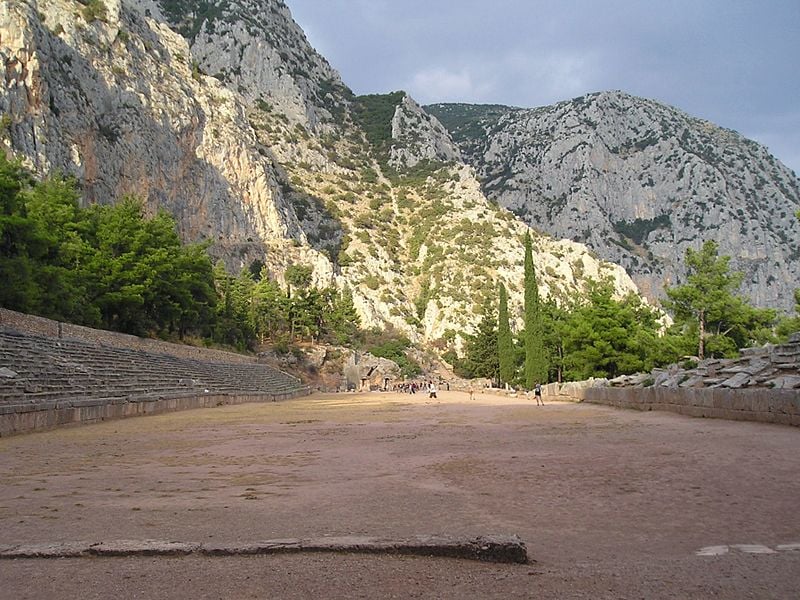
The Mountaintop Stadium at Delphi
The stadium is located even further up the slopes of Mt. Parnassus, beyond the Via Sacra and the theater. It was originally built in the 5th century BC but was altered in later centuries. The last major remodeling took place in the 2nd century AD under the patronage of Herodes Atticus, when the stone seating and arched entrance was built. It could seat an amazing 6,500 spectators and the track was 177 meters (580 feet) long and 25.5 meters (83 feet) wide.
Delphi’s Hippodrome Once Site of Chariot Races
It was at the Pythian Games that prominent political leaders, such as Cleisthenes, the tyrant of Sikyon, and Hieron, the tyrant of Syracuse, competed with their chariots. The hippodrome where these events took place was referred to by Pindar, and this monument was sought by archaeologists for over two centuries.
In 2012, Professor of Classical Archaeology Panos Valavanis declared that he had found the site of the hippodrome at “Gonia,” at the west end of the olive grove at Delphi, nearly 1.5 km northeastern of Itea, running parallel and adjacent to the Kefali mountain range, between the Aghioi Anargyroi and Gla hills.
The Polygonal Wall
This retaining wall was built to support the terrace housing the construction of the second temple of Apollo in 548 BC. Its name is taken from the polygonal masonry of which it is constructed. At a later date, from 200 BC onward, the stones were inscribed with the manumission contracts of slaves who were consecrated to Apollo. Approximately a thousand manumissions are recorded on the wall.
The sacred spring of Delphi, called the Castalian Spring, lies in the ravine of the Phaedriades. The preserved remains of two monumental fountains that received the water from the spring date to the Archaic period and the Roman, with the latter cut into the rock.
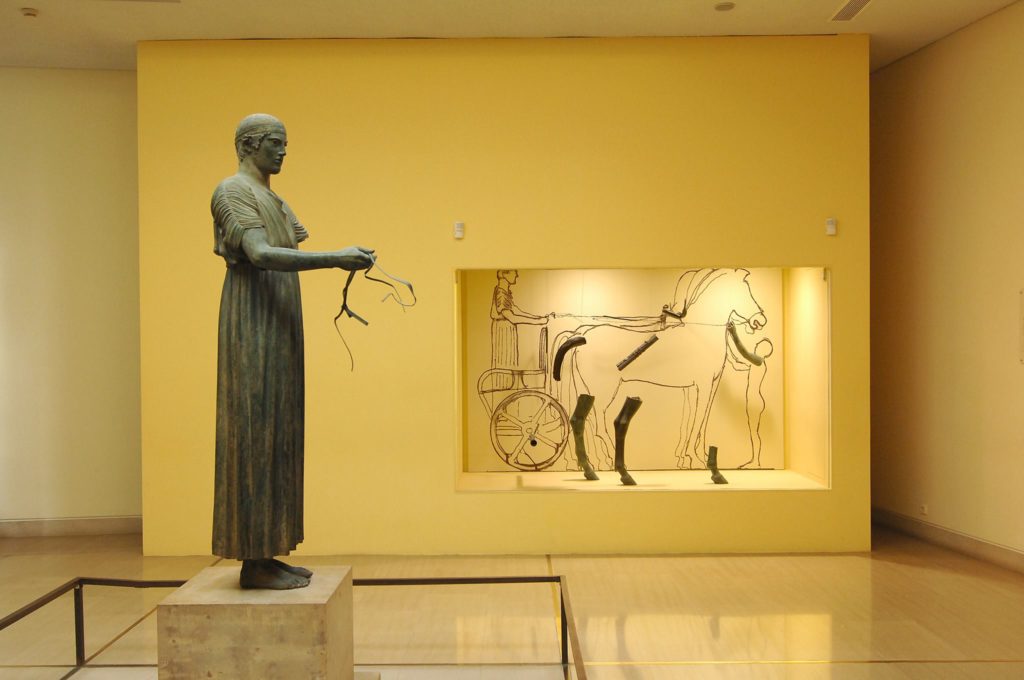
The Charioteer of Delphi, Greece
Created in 478 or 474 BC, and now housed at the Delphi Museum, The Charioteer, is one of the best known statues from antiquity.
The exquisite bronze statue, which somehow survived over the millennia, has lost many features, including his chariot and his left arm. However, he stands today as a stunning tribute to the athletic art of antiquity.
The Last Oracle
The site was sacked by Lucius Cornelius Sulla in 86 BC during the Mithridatic Wars.
In 83 BC a Thracian tribe raided Delphi, burned the temple, plundered the sanctuary and stole the “unquenchable fire” from the altar. During the raid, part of the temple roof collapsed. That same year, the temple was severely damaged by an earthquake, thus it fell into decay and the surrounding area became impoverished. The sparse local population led to difficulties in filling the posts required. The oracle’s credibility finally waned due to predictions that did not come true.
The mentally unstable Roman emperor Nero, who himself sacked Delphi, still relentlessly tried to learn the timing and circumstances of his death from the Oracle there.
The message he received was “beware of the seventy-third year,” so the emperor continued on in a false sense of security, until shortly afterward he was killed by Galba who –coincidentally or not — happened to be 73 years of age.
However, that’s not the only question asked of the oracle. Lead tablets reveal that the Roman orator Cicero asked the rather embarrassing question: “how to become famous.” Although subsequent Roman emperors of the Flavian dynasty contributed towards to the restoration of the site, it gradually lost its importance.
The oracle flourished again in the second century AD during the rule of emperor Hadrian, however, who is believed to have visited the oracle twice and offered complete autonomy to the town.
In the course of the 3rd century AD, mystery cults became more popular than the traditional Greek pantheon, and Delphi became the seat of a Christian bishopric.
Despite the rise of Christianity across the Roman Empire, Delphi remained a religious center throughout the 4th century, and the Pythian Games continued to be held at least until 424 AD; however, the decline continued. The attempt of Emperor Julian to revive polytheism after Christianity had become widespread was not successful.
He sent his physician to Delphi to rebuild the Temple of Apollo, and received an oracle for his efforts that “the speaking water has been silenced,” which became known as “the last oracle” and is recorded by George Kedrenos.
The Sacred Way, once the site of pilgrims from another time, remained the main street of Delphi, but it was transformed into a street with ordinary commercial and industrial use. Around the agora were built workshops as well as the only intra muros early Christian basilica.
Houses were built mainly in the western part of Delphi. Archaeologists say that they were quite spacious and two large cisterns provided running water to them.
In the 1800s, when the French School took over the town for excavations, the entire town and its residents were moved to the new town of Delphi, adjacent to the ancient settlement, leaving the ancient stones and monuments to be revealed again to the world so that they could tell their story.
